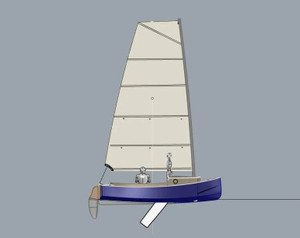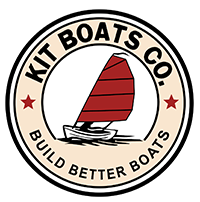
Below are two articles on the orignal Skate 15 design. We are still working on pricing for the updated version of the CNC kit. Please send us a note if you are interested. —Josh and Brandon
Port Townsend is an unusual place. The official population is only 9300 souls, yet this area produces or attracts a wildly disproportionate percentage of the world’s nautical expertise. There are multiple residents, for example, who have personally authored texts regarded as the “bible” on whatever arcane maritime subject they’ve expounded. Iconic boat designs, fabled maritime institutions, and renowned sailing events have all been born here.
I learned just how fertile this sort of environment can be during our SCAMP project. After John Welsford had done his brilliant work designing the essential boat from New Zealand, local designer and builder Kees Prins, and CAD/CNC-designer Brandon Davis (Turn Point Design) put their considerable minds to helping develop Scamp more fully, making numerous important contributions. Several times we even picked up an important suggestion or modification idea from an expert sailor, designer or boat builder who just happened to walk past the prototype build at the Northwest Maritime Center. There is definitely a bit of Port Townsend in Scamp’s DNA.
I was reminded of all of this the other day when Brandon Davis stopped by the office. We were talking boats as usual when I asked him why nobody has yet designed a super fast, pie-slice-shaped, Mini-Transat-style boat—something that features most of the exotic go-fast ideas—in a simple, inexpensive kit that a boat builder could whip-up in the backyard. I wasn’t thinking about an ocean-crosser, but something that would be a blast in a Texas 200, Everglades Challenge, R2AK, or small-boat raid—an off-the-wind rocket that a couple of crew could still comfortably beach-cruise and camp aboard. As it happens, Brandon couldn’t get the idea out of his head, and when I opened my e-mail the next day there was a drawing that looked a lot like what you see here.
Imagine a 15-foot-long, 8-foot wide (at stern) boat that doesn't weight much, but carries 190 square feet of sail (not counting the asymmetrical spinnaker), and sleeps two comfortably inside the cabin or out in the cockpit.
Introducing the Skate 15.
A modern, fat-headed boom-less mainsail sets on a foam-filled wingmast (Hobie 14 section), and there’s a retractable bowsprit (old windsurf mast) to set an asymmetrical spinnaker or code zero. There are twin rudders and a deep NACA-profile daggerboard designed to kick aft on impact. Below the seats are water ballast tanks designed to fill the windward side and flush to the other side on tacks. Or fill them both to settle the boat down for more relaxed daysailing.
The wide beam of the planing hull means when Skate heels to 15 degrees, 35% of the hull is out of the water, vastly reducing wetted surface. If all goes as planned she’ll do eight-plus knots to weather. Off the wind? You might want to buckle up.
The cabin offers surprisingly comfortable accommodations with a raised V-berth area for stowage, a slanted half-bulkhead for reclined sitting, and a sprawling double berth from the cabin under the raised cockpit.
At every stage we’ve tried to consider cost and complexity, aiming for a simple build and inexpensive materials—from repurposed common parts to things the builders can make themselves. Her deceptively simple plywood shape and the inclusion of a building jig should mean quick construction.
With regard to safety, multiple sealed compartments, collision bulkheads, and a watertight main companionway hatch will keep her afloat always, and her boom-less rig with lines led aft means the crew doesn’t need to worry about going forward or being hit in the head.
The local cognoscenti—designers, racers, and builders who come by Brandon’s shop—have all been weighing in of course, poring over the drawings and sharing their advice, and all seem to think we’re on the right track (several have inquired about building their own). We keep imagining a brightly-colored fleet of Skate 15s flying down some scenic waterway for a week-long beachcruising adventure.
The prototype should be under construction by the time you read this, with kits possibly being available soon after early summer sea trials. Watch these pages for future updates
UPDATE
As most of you know, the prototype was completed and we've been out sailing it. The verdict? Skate is incredible! Easy to sail, responsive, weatherly, and fast. We think she’s on her way to becoming a well-known adventure-racer/ performance beach cruiser.
In fact we even had a chance to test her beach-cruising capabilities recently when Brandon and I took our daughters for an overnight. We sailed over to Marrowstone Island, pulled Skate up the beach on inflatable rollers, and made camp. The huge cockpit handled the four of us easily under sail and the kids loved crawling around in the big cabin and watching the water through the transom’s escape-hatch glass.
One of the last boxes we wanted to tick in our prototyping process was a capsize and recovery test, and we did that a few weeks ago. Once again Skate did everything we'd hoped. With her beam and water ballast she was difficult to knock over (even with two crew hiked-to-leeward with sails sheeted tight in light air, she was hard to knock down—the sailors failed several times then eventually put her on her side.) Once knocked down she sat incredibly high—water was nowhere near the cockpit or companionway—and one crewmember was able to right the boat by grabbing the centerboard.
And finally, when we knocked her over again and tried to intentionally turn her 180º, she resisted mightily. Because of the sealed Hobie 16 wing mast, Skate was nearly impossible to invert. It took several minutes of both crewmembers walking on the mast from the tip toward the hull, pulling on shrouds as they went, to force the boat upside down. And once inverted, two crewmembers pulling on the righting line were able to right Skate easily. As I say, everything we could have hoped for.
And just recently we had world-class sail designer Bob Pattison from Neil Pryde Sails out for a second time to go over Skate's rig and controls, so those systems are also pretty well dialed. We're trying to do this right so that we create a solid class sailboat right out of the gate, with perfect off-the-shelf sails available.
One of the last things we're looking to add to Skate (again working with Bob and Neil Pryde) is a so-called Code Zero sail on a furler. The Code Zero—which is sort of a cross between a genoa and asymmetrical spinnaker—is easy to manage and appropriate to use over a huge range, making it a perfect fit for Skate 15 adventures.
* Kit price includes kit foils (rudder blades and centerboard).
BUILD TIME AND DIFFICULTY RATING: Moderate (approx 400 hours)












